Essential Pool Filter Sand Tips for Crystal Clear Water
January 29th, 2024
January 29th, 2024
A sparkling pool is often the crowning jewel of a summer's day, inviting laughter and leisurely swims. Yet, beneath the shimmering surface lies a crucial component deserving attention—the pool filter sand. For those who've ever dipped their toes into the world of pool maintenance, the importance of changing this sand is no secret. Over time, the grains become clogged with debris, algae, and oils, reducing the filter's efficiency. Neglecting this task can lead to cloudy waters, forcing one to sacrifice swim time for frustrating clean-ups.
Years ago, I faced a similar dilemma. My backyard oasis, once clear and inviting, had turned into a murky mystery. After some research and a bit of trial and error, I discovered that replacing the filter sand was the key to restoring its former glory. The process, while slightly daunting at first glance, transformed into a manageable task with the right guidance and tools.
Every pool owner, regardless of experience, can benefit from a straightforward approach to this essential maintenance. It's not just about swapping out old sand for new; it's about understanding the rhythm of your pool's needs and ensuring that every swim is enjoyed to its fullest potential. In the following guide, we'll explore the step-by-step process, tips to make the job easier, and insights that can save both time and effort. Your pool deserves the best, and so do you.
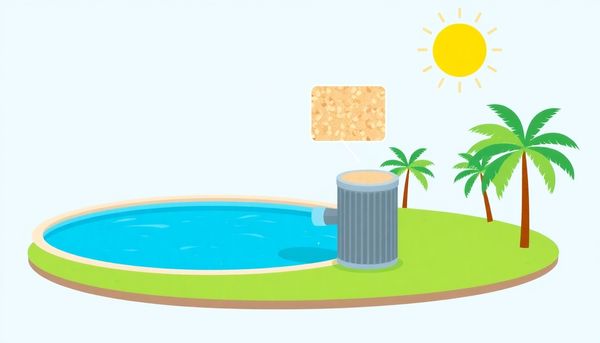
Selecting the perfect type of sand for your pool filter is akin to choosing the right tool for a delicate job; it demands precision and knowledge. Each grain of sand plays a pivotal role in the filtration process, ensuring your pool remains a haven of clarity and hygiene. So what should you look for when standing in front of those towering bags of sand at the pool supply store?
First, consider #20 silica sand, the industry standard. It's not just any sand; it’s crafted from finely ground quartz, its grains purposefully sharp and angular. These jagged edges are essential as they excel at capturing unwanted debris and impurities. However, keep in mind that not all sands are equal. That cheap play sand left over from a summer project might seem tempting, but it could wreak havoc on your filtration system, leaving you with more headaches than crystal-clear water.
Alternatively, glass sand might catch your eco-friendly eye. Made entirely from recycled glass, this option is not only sustainable but also efficient. Its mixed-sized grains and negative charge work wonders in trapping particles, especially beneficial if your water source is hard or tinged with metals like iron.
For those grappling with persistent chloramine issues, zeolite sand could be a game-changer. Originating from volcanic minerals, it offers a massive surface area for filtration and adeptly traps chloramines, reducing the frequency of chemical treatments.
Finally, for a modern twist, consider filter balls. Lightweight yet powerful, these fiber spheres offer ease of use and longevity, simplifying maintenance with less frequent backwashing.
Choosing the right sand ensures your pool filter operates at its best, granting you more time to savor those sun-drenched days by the pool.
Choosing the correct type of sand for your pool filter can feel like a puzzle, but it's an essential step for maintaining a pristine aquatic oasis. The sand acts as a sentinel, capturing debris and particles that cloud your water. However, not all sands are equal in this task, and selecting the wrong type can sabotage your filter system.
Among the options, #20 silica sand is a perennial favorite. This sand is made from ground quartz, forming gritty grains that excel in trapping unwanted particles. Although it's not the most eco-friendly choice due to the mining process, its efficiency is hard to beat. When you pour this into your filter, you can rest assured that the sand's rough edges will keep your pool water clear by catching even the tiniest intruders.
For those keen on sustainability, glass sand offers a green alternative. Crafted from recycled glass, it not only reduces environmental impact but also boasts the ability to filter particles as minute as two microns. Its unique grain sizes help prevent channeling, ensuring your filter remains effective without requiring frequent maintenance.
If you seek advanced filtration, consider zeolite sand. Derived from volcanic minerals, this option offers an impressive surface area and can chemically trap chloramines, reducing the need for chemical shock treatments. Its molecular sieving ability makes it a smart choice for pools experiencing frequent chloramine buildup.
Navigating these options might seem daunting, yet each type of sand brings its own set of benefits. Whether your priority is ecology, efficiency, or chemical control, there's a sand suited to your pool's needs.
Before embarking on the sand-changing journey, understanding your pool's specific needs is crucial. Every pool is unique, not only in its size but also in its usage and surrounding environment. Consider a friend with a pool nestled under shady trees; they often faced more leafy debris than someone with a sun-soaked, open space pool. Factors like this can significantly influence your choice of sand.
Firstly, assess the volume of your pool and the number of swimmers it accommodates regularly. Larger pools with frequent use may demand sands that handle higher loads and finer filtration. Look at your local water source too. Hard water, rich in minerals like iron and manganese, might necessitate a filtering medium with a high capture rate, such as glass sand. Unlike traditional silica, it efficiently traps these minerals, preventing unsightly stains and maintaining water clarity.
Next, contemplate your maintenance routine. If weekly backwashing feels like a chore, perhaps the minimal upkeep filter balls offer could be your ally. These lightweight alternatives eliminate cumbersome sand handling and reduce backwashing frequency, making them perfect for those who cherish convenience.
Lastly, environmental impact is worth pondering. If sustainability is a priority, choosing a medium like glass sand, crafted from recycled glass, aligns with eco-conscious values. Each choice reflects not just pool care needs but a lifestyle preference. By evaluating these aspects, you ensure the sand you select complements your pool perfectly, keeping it sparkling and inviting year-round.
Navigating the world of pool filter sand can feel like treading murky waters if you're not careful. Many pool owners stumble through common pitfalls, turning a simple task into a tangled mess. To keep your pool sparkling and your filter functioning smoothly, steer clear of these frequent blunders.
First, resist the urge to use any old sand lying around, like play sand or beach sand. These types may seem convenient, but they can wreak havoc on your filtration system. Play sand, for instance, lacks the specific size and shape required for effective filtration, leading to clogs and poor water clarity. Always opt for #20 silica sand, recycled glass sand, or zeolite for optimal performance.
Another common error is neglecting to replace sand at the right time. Over time, pool filter sand loses its edge, both literally and figuratively. Its rough surface smooths out, reducing its ability to trap particles. Ensure you replace the sand every three to five years or when you notice decreased water clarity and increased filter pressure.
Lastly, don't forget to backwash regularly. Allowing debris to accumulate without proper cleaning can not only reduce filtration efficiency but also increase pressure within the system, causing potential damage. Keep an eye on the pressure gauge, and backwash whenever it reads 10 psi above normal.
By avoiding these mistakes, you'll maintain a pristine pool environment—leaving you more time to enjoy those sun-drenched afternoons by the water.
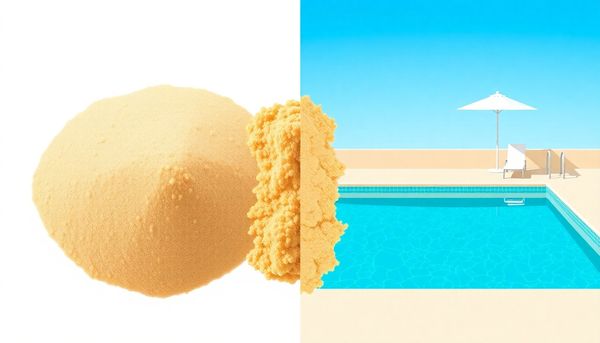
Changing pool filter sand might seem daunting, but it's really about removing the old sand to make way for the fresh stuff. First, ensure your filter and pump are completely turned off—no surprises needed. Once everything is safely powered down, it's time to drain the filter tank. Unscrew the drain plug at the bottom and let gravity do its work. This part is a bit like watching paint dry, but patience pays off.
Now, getting to the core of it involves a little disassembly. Disconnect any hoses and pipes from the multiport valve. If you find yourself staring at hard PVC pipes, a hacksaw might be your best friend, unless you're more comfortable with a professional's touch. For future ease, consider installing union fittings—next time, it'll be as simple as unscrewing a jar lid.
With the multiport valve removed, cover the open pipe inside the tank with duct tape. This prevents sand from sneaking into unwanted places. Then, grab a trusty Shop-Vac. This hefty helper will make short work of sucking out the old sand, saving your back and precious time. Without one? A plastic cup will do, but prepare to be there awhile.
As the last grains disappear, rinse the tank thoroughly. It’s like giving your filter a spa day, ensuring it’s ready for the fresh, jagged-edged sand that turns murky pool water into a crystal-clear oasis.
Selecting the right sand for your pool filter feels a bit like choosing the perfect ingredients for a recipe; one wrong selection and the whole system could be thrown off balance. Not all sand is created equal—using any random sand could harm your filtration system and leave your pool murky. Instead, you’ll need to opt for one of the specialized types: silica sand, glass sand, or zeolite.
Silica sand, also known as #20 silica sand, is the classic choice. Its sharp, angular grains are excellent for catching debris as water flows through the filter. Always sourced from ground quartz, this sand is highly effective but doesn’t boast the environmental credentials of its counterpart, glass sand.
For those with eco-friendly aspirations, glass sand is the hero of the hour. Made entirely from recycled glass, it offers a low environmental impact and still captures fine particles effectively. Its unique feature is its ability to minimize channeling due to its varied grain sizes, which prevents water from bypassing the filtration media.
Then there's zeolite, a volcanic rock-based alternative offering advanced filtration capabilities. Its capacity to trap chloramines through molecular sieving makes it a superb choice for pools frequently troubled by irritating chlorine byproducts.
Lastly, filter balls present a modern twist on traditional sand. Lightweight and easy to handle, these polyester-based spheres ensure efficient filtration with reduced maintenance.
Choosing between these options depends largely on your pool's specific needs and your personal priorities, whether that’s sustainability, performance, or ease of maintenance.
Switching out the sand in your pool filter might seem like a daunting task, but with a little preparation, it can be as straightforward as a summer breeze. Before you start, gather everything you need to avoid interruptions. Trust me, you don't want to realize halfway through that you’re short on supplies. Remember my neighbor Jim? He ended up borrowing my Shop-Vac when his back gave out from manually scooping sand. Lesson learned: preparation is key.
Start by choosing the right sand for your filter. While it might be tempting to use that leftover play sand in the garage, resist the urge. Only use #20 silica sand, glass sand, or another sand substitute specifically designed for pool filters. Each type has its pros and cons, but all ensure your filter operates efficiently. Silica sand is the classic choice, while glass sand, made from recycled materials, offers a more eco-friendly option. Zeolite and filter balls are other alternatives to consider, especially if you’re dealing with chloramines or want reduced maintenance.
Once your supplies are ready, check your tools. A utility knife, duct tape, and a garden hose will all come in handy. Set aside a few hours for the job, ideally in the morning or late afternoon when the sun isn’t directly overhead. Not only will this make the task more comfortable, but it also gives you plenty of daylight to spot any issues with the filter components. With everything prepped, you’re set to tackle the sand replacement like a pro.
Tackling the task of installing and backwashing new sand in your pool filter might sound daunting, but it's surprisingly straightforward. First, ensure you have the right type of sand—specifically, pool filter sand or a suitable alternative like glass sand or zeolite. With your selected sand at hand, you're ready to breathe new life into your filtration system.
Begin by carefully adding the new sand into the filter tank. It's crucial to pour it gently to avoid damaging the laterals, those delicate pipes that spread out beneath the sand. Filling the tank about halfway with water before adding sand acts as a safety cushion, reducing the impact. As you pour, savor the quiet satisfaction of knowing your pool will soon be back to its sparkling best.
Once the new sand is settled, it’s time to perform a thorough backwash. Attach the backwash hose, set the multiport valve to backwash, and turn on the pump. This process flushes out dust and tiny particles from the fresh sand, ensuring it’s primed for optimal filtration. Follow up with a rinse cycle to complete the preparation. This step ensures any residual sand dust is cleared, thus preventing it from making its way into your pool.
Finally, switch the valve to the filter setting and turn the pump back on. Monitor the pressure gauge to establish your filter’s new normal running pressure. Keeping an eye on this will help you determine future backwashing schedules, allowing your pool filter to work efficiently without unnecessary wear. With these steps complete, you'll be swimming in clear waters, knowing your filter’s in top shape.
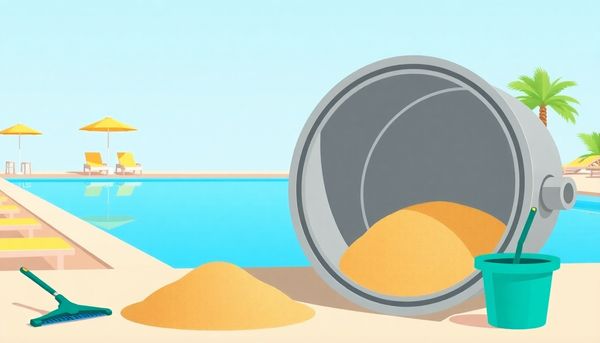
Replacing pool filter sand is a task that requires both patience and precision. This isn’t just another day at the pool; you’re ensuring that every lap and cannonball dives into crystal-clear water. It starts with selecting the right sand. Remember, not all sand is equal. #20 silica sand, glass sand, and zeolite each offer unique benefits tailored to your pool’s needs. Whether you’re minimizing chloramines or maximizing sustainability, choosing the right type is crucial.
With your sand choice in hand, prepare the tank. Drain the water thoroughly and take a moment to ensure every connection is secure before moving on. Disconnect hoses carefully and ease the multiport valve from its snug position atop the tank. This step may feel like unlocking a secret compartment, revealing the sand’s hidden world beneath.
As you vacuum out the old sand, picture the years of grime and grit that once lurked in your pool vanishing into the ether. A Shop-Vac is your best friend here, saving time and aching muscles. Don’t forget to give those laterals a good rinse to remove lingering grains.
Before adding fresh sand, fill the tank with some water to cradle the laterals. This protects them from the weight of the new sand. Wearing a dust mask, pour the sand slowly, savoring the sound of each grain finding its place. Once filled, reassemble the filter, backwash thoroughly, and rinse to clear out any dust. Your new sand is ready for action, set to deliver sparkling water for years to come.
In the world of pool maintenance, selecting the right type of sand for your filter can feel like choosing the perfect wine pairing. It's not just about grabbing the first bag you see; the wrong choice could lead to an ineffective filter that costs you time and money. Knowing the differences between sand types can transform your pool care routine from a tedious task to a streamlined process.
Silica sand, often branded as #20 grade, is a favorite among many pool owners. Its sharp, angular grains make it excellent at trapping debris. This type of sand is generally affordable and widely available, making it a convenient choice for those who prioritize ease and traditional solutions. However, its environmental impact might give some pause.
If you're after an eco-friendlier option, glass sand emerges as a formidable contender. Crafted from recycled glass, this media captures particles down to two microns. Its varying grain sizes reduce the risk of channeling, ensuring your water's clarity. An added perk? Its ability to hold onto metals like iron and manganese, crucial for pools filled with hard water.
For those battling persistent chloramine levels, zeolite sand offers a unique advantage. Derived from volcanic minerals, it boasts a larger surface area than traditional sand, improving filtration. Its molecular sieving capability traps chloramines effectively, reducing the need for frequent chemical treatments.
Lastly, filter balls present a modern twist on pool filtration. Lightweight and reusable, they provide the equivalent filtration power of traditional sand without the heavy lifting. Each option has its strengths, so consider your pool's specific needs and your personal preferences when selecting your media. A little research now can save a lot of hassle later.
In the bustling world of pool maintenance, preparing to change your pool filter sand is a task that requires a bit of foresight and organization. Before diving into the dismantling process, ensure you have all necessary tools and materials at your disposal. This includes a screwdriver, duct tape, a Shop-Vac, a garden hose, a flashlight, and, of course, your new sand or chosen sand alternative.
First things first, turn off the pool pump and filter entirely. A simple oversight here could lead to a hefty repair bill if the pump accidentally runs dry. After ensuring the system is off, drain the water from the filter tank by removing the bottom plug. It’s a good idea to allow the filter to drain in the morning, giving you time to tackle the rest of the job in the cooler hours of the evening—or whenever suits your schedule best.
Next, detach any hoses or pipes connected to the multiport valve. For those with PVC plumbing, this might involve cutting the pipes. It’s worth considering adding union fittings during reassembly to make future maintenance a breeze. With the pipes out of the way, use your screwdriver to remove the clamp or collar holding the valve to the tank.
Gently twist and lift the multiport valve off the tank, being cautious of the laterals branching out within the sand. These delicate components resemble tree roots and can be easily damaged. Cover the open standpipe with duct tape to avoid filling it with sand, which could lead to contamination when the system restarts.
As you venture further into the heart of the filter, your trusty Shop-Vac becomes your best friend. This device will swiftly and efficiently remove the old sand, saving you from the backache of manual removal. Remember, leaning on technology is often the smart choice—it brings both efficiency and simplicity to the task.
In the intricate dance of pool maintenance, mastering backwashing techniques becomes a silent partner in keeping your water clear and inviting. A crucial process, backwashing ensures that your filter sand maintains its efficiency by flushing out trapped debris. Just like when you clean out the lint trap in your dryer, backwashing prevents build-up that could cause your filter to work harder than necessary.
Begin by monitoring your pressure gauge—it’s your guiding star. When the reading rises about 10 psi above the normal level, it signals that the filter is working too hard and needs a break, akin to how you would notice when your car's oil light turns on. First, turn off the pump to avoid any mishaps, then switch the multiport valve to the backwash position. This sets the stage for reversing the flow of water through the filter, freeing the captured debris.
Once activated, let the backwashing process run for about two minutes or until the sight glass runs clear. Afterwards, switch to the rinse setting briefly to settle the sand before returning to the filter position. This step is like giving your filter a refreshing rinse after a deep clean—ensuring no debris sneaks back into the pool.
Consistency is key here. Regularly performing this routine not only extends the life of your sand but also keeps your pool shimmering. With each backwash, you're essentially giving your filter a fresh start, much like resetting your gadgets for optimal performance.
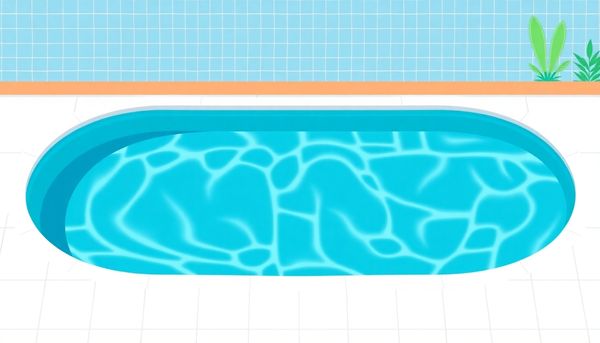
Maintaining a pool filter is much like caring for a well-loved car—it needs regular attention to perform at its peak. One of the essential steps in this process is backwashing. Picture this: after a long day, you hop into your pool to find the water less sparkling than you remember. This is often a signal that your filter is crying out for a good backwash.
Backwashing is akin to giving your filter a refreshing shower, clearing it of accumulated debris and ensuring the sand can do its job effectively. When your filter’s pressure gauge reads 10 psi above the usual, it's time to spring into action. This method, which reverses the flow of water through the filter, dislodges dirt and grime caught in the sand, sending it directly to waste. It’s not just about maintaining clarity; it’s about extending the life of your filter by reducing the risk of sand channeling and clogs.
A personal tip: incorporate backwashing into your weekly pool care routine. Not only does it help maintain clear water, but it also prevents the buildup that can result in costly repairs down the road. And don't forget to check the pool’s water level afterward—backwashing can lower it slightly, necessitating a top-off. Regular attention to backwashing means more time enjoying your pool and less time worrying about maintenance.
Deciding on the right filter media for your pool isn’t merely a choice; it's an art form that determines how efficiently your pool stays clean. Each type—silica, glass, zeolite, or filter balls—has its unique benefits, tailored to different pool needs and water conditions.
Silica sand is the stalwart of pool filters, known for its affordability and effectiveness. Its sharp, angular grains are adept at trapping particles and ensuring sparkling water. My neighbor swears by it, noting that her pool remains clear even during peak swimming months. Yet, its environmental footprint may give some pause, prompting a search for greener alternatives.
Enter glass sand, crafted from recycled glass, offering a smoother yet highly effective option. Its ability to filter particles as small as two microns makes it a favorite among eco-conscious pool owners. It not only minimizes channeling, thanks to its varied grain sizes, but also holds a negative charge, attracting pesky metals like iron and manganese. A family friend opted for glass sand recently and noticed fewer issues with hard water deposits.
For those battling chloramines and frequent shocks, zeolite emerges as a hero. Its honeycomb structure offers an expansive surface area, trapping contaminants chemically. Meanwhile, filter balls, the newest innovation, promise ease and longevity, effectively replacing traditional sand with minimal maintenance demands.
Ultimately, the right choice hinges on your pool’s unique requirements and personal values. Whether prioritizing cost, environmental impact, or maintenance ease, each option holds the promise of a clearer, cleaner swimming experience.
Replacing the sand in your pool filter doesn’t have to be a daunting task; mastering a few techniques can make it straightforward and rewarding. Your first consideration should be the type of sand best suited to your pool’s needs. While #20 silica sand is the go-to for most, the eco-friendly glass sand or high-performing zeolite might fit your situation better. Each type has its unique benefits, from trapping particles down to a microscopic level to maintaining low environmental impact.
Before diving into the replacement process, gather your tools. You’ll need a Shop-Vac, duct tape, a garden hose, and a trusty utility knife. Once you’ve turned off your pool pump, disconnect the multiport valve with care to avoid damaging the laterals. A Shop-Vac makes quick work of sand removal, saving your back and hours of labor. Rinsing the tank with a garden hose ensures any leftover grains are washed away before new sand is added.
Adding new sand requires a gentle touch. Fill the tank halfway with water to cushion the laterals, preventing damage as the sand is poured in. When slicing open bags of sand, take a moment to enjoy the process, but remember to keep the dust at bay with a mask. After sealing everything back up, a crucial step is backwashing the filter to clear out any dust and debris from the fresh sand.
By maintaining a regular check on the pressure gauge and performing backwashes as needed, you’ll ensure your filter operates smoothly. With these techniques, you’ll enjoy a crystal-clear pool and an efficient filter, making your swim sessions worry-free for years to come.
As we chat about keeping your pool filter in tip-top shape, it's worth noting that the pursuit of crystal-clear water doesn’t end with changing the sand. It's about enhancing the ongoing effectiveness of that trusty sand filter. Ever wonder how some pools sparkle like a gem under the sun while others struggle to stay clear? The secret often lies in the details of filtration efficiency.
Begin with the type of sand you're using. While #20 silica sand is a common choice, considering alternatives like glass sand can yield significant benefits. Glass sand, made from recycled glass, offers not only environmental perks but also superior filtration capabilities, capturing particles as small as two microns. Its mixed grain sizes help prevent channeling—a sneaky problem where water cuts a shortcut through the sand, bypassing the filtering process.
Moreover, don't shy away from adding a little diatomaceous earth (D.E.) powder to your sand. This can enhance the sand’s ability to trap finer particles and keep your water cleaner. Regular backwashing is essential, too. It prevents pressure build-up and keeps the filter from becoming a breeding ground for bacteria and algae. If you occasionally use a sand filter cleaner, you’ll remove oils and other residues that simple backwashing might miss.
Lastly, avoid the urge to overdo it with backwashing. Stick to checking the pressure gauge—usually, a 10 psi increase from the norm signals it's time. By maintaining these practices, your pool filter will work more efficiently, saving you both time and money while delivering that dazzling, inviting pool water we all love.
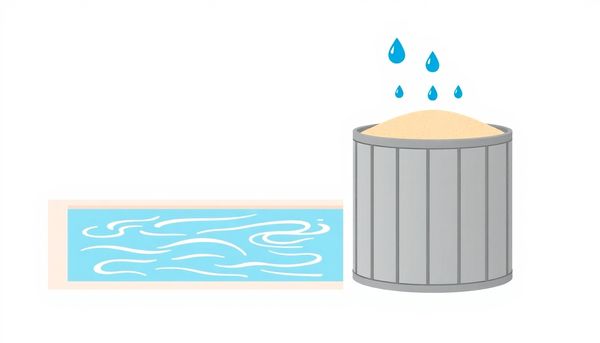
Without proper maintenance, even the most efficient pool filter sand loses its edge over time. Each grain of sand plays a vital role in capturing debris, but as the surface wears down, it becomes less effective at filtering water. Over time, the continuous flow of water smooths these grains, making them unable to trap unwanted particles. To maintain filter efficiency, regular checks and upkeep are crucial.
Begin by monitoring your pool's water clarity and pressure gauge. A spike in pressure or cloudy water often signals that the sand has reached its capacity for holding contaminants. Backwashing the filter, a process that reverses the water flow to flush out accumulated debris, is an effective short-term fix. However, this should be done judiciously to avoid over-cleaning, which can diminish the sand's crucial rough texture.
In addition to routine backwashing, consider an annual deep clean with a sand filter cleaner. This removes oils and fine particles that backwashing alone might miss. When your sand hits the three to five-year mark, it’s time to consider a replacement. The wear and accumulation of debris within the sand signify it's beyond rejuvenation, thus impacting your pool’s water quality and potentially increasing chemical use.
Remember, maintaining filter efficiency is about balance. With consistent attention and care, your pool filter will continue to provide pristine water, allowing you more time to enjoy those sunny days by the poolside.
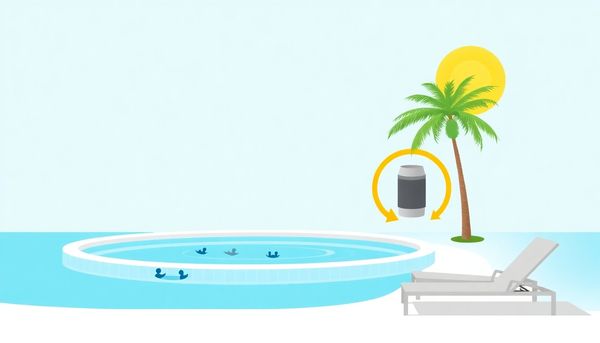
This article provided insights into maintaining your pool. Start your pool care journey today!
Want to become a pool maintenance expert? Our free Pool School course covers everything you need to know about pool care. From basic maintenance to advanced troubleshooting, you'll learn how to:
Join over 10,000 pool owners who have already transformed their pool care routine. Get started with our free Pool School course today!